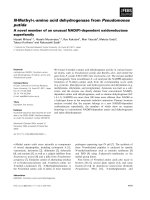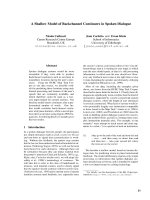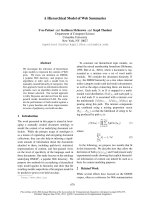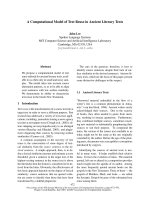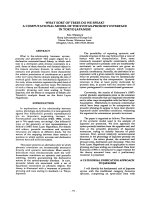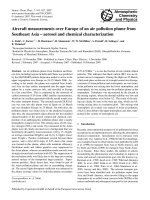A simulation model of an air cargo import terminal
Bạn đang xem bản rút gọn của tài liệu. Xem và tải ngay bản đầy đủ của tài liệu tại đây (736.66 KB, 91 trang )
A SIMULATION MODEL OF
AN AIR CARGO IMPORT TERMINAL
LEONG CHUN HOW
(B. Eng. (Hons), UM)
A THESIS SUBMITTED
FOR THE DEGREE OF MASTER OF ENGINEERING
DEPARTMENT OF INDUSTRIAL AND SYSTEMS ENGINEERING
NATIONAL UNIVERSITY OF SINGAPORE
2004
I
ACKNOWLEDGEMENTS
I would like to express my gratitude and appreciation to my supervisors, Associate
Professor Huang Huei Chuen and Associate Professor Chew Ek Peng for their great
patience, advice and support throughout this course. Besides, I would like to thank
research fellow Dr. Paul Goldsman for his advice.
I also wish to thank air logistics industrial people (Mr. Andrew Seow, Mr. Ang See Perk,
Mr. Poon Keng Luen, Mr. Hoa Kai Ee and Mr. Muhamad Saaim Bin Alias) and The
Logistics Instititute-Asia Pacific staffs (Mr. Lee Yen Soon, Mr. Tan Poh Seng, Mr. Zane
Tan, Ms Charlotte Wong Shou Fang and Mr. James Lin Xueshan) for their support and
encouragement.
II
TABLE OF CONTENTS
ACKNOWLEDGEMENTS I
TABLE OF CONTENTS II
SUMMARY IV
LIST OF FIGURES V
LIST OF TABLES VII
CHAPTER 1: INTRODUCTION 1
1.1 Motivation 1
1.2 Background 3
1.3 Scope 8
1.4 Outline of the Study 9
CHAPTER 2: LITERATURE REVIEW 10
2.1 Introduction 10
2.2 Simulation of Sea Port Operations 10
2.3 Simulation of Air Cargo Terminal Operations 13
CHAPTER 3: MODELING APPROACH 15
3.1 The Simulation Model - Overview 15
3.2 The Simulation Model - Material Flow Processes 17
3.2.1
Receiving
17
3.2.2
Break bulk
29
3.2.3
Storage and Cross docking
31
3.2.4
Retrieval and Skid-building
32
III
3.2.5
Return Trip
36
3.3 Number of Forklifts 37
3.4 Clustering Policy 37
3.5 Convenience Rule 40
3.6 Skid-building Rate 54
CHAPTER 4: SIMULATION ANALYSIS 55
4.1 Verification and Validation 55
4.2 The Peak Hour 57
4.3 The Evaluation of the Number Forklifts 59
4.4 The Evaluation of the Clustering Policy 66
4.5 The Evaluation of the Convenience Rule 66
4.6 The Evaluation of the Skid-building Rate 66
CHAPTER 5: CONCLUSIONS & RECOMMENDATIONS 69
5.1 Conclusions 69
5.2 Recommendations 70
REFERENCES 73
APPENDIX 79
Cargo Attributes 79
IV
SUMMARY
This thesis presents a simulation study of the material flow system in a highly
mechanized air cargo import terminal with limited space availability. Most existing
research in this area has focused on specific activities in the terminal, such as automated
storage and retrieval systems. Highly mechanized system in air cargo terminal does not
guarantee an effective material flow system if without an effective working policy.
Without studying realistically the impact of interaction effects among the activities, it is
hard to produce an effective working policy. This research is the first attempt to use
simulation to study the interaction effects among activities and storage systems in the
terminal. We describe the main activities that need to be modeled in building a realistic
and accurate simulation of an air cargo terminal. It is often difficult to characterize the
attributes of the air cargo and we propose a systematic procedure to overcome this
difficulty. Finally, we show how simulation can be used to evaluate existing and
proposed working policies.
V
LIST OF FIGURES
Figure 1: Cumulative Distribution for AWB Assignment to ULD 20
Figure 2: PCHS Cargo Weight Profile 23
Figure 3: Rack Cargo Weight Profile 23
Figure 4: AS/RS Cargo Weight Profile 24
Figure 5: Big Cargo Agent Request Time Cumulative Distribution 27
Figure 6: Small Cargo Agent Request Time Cumulative Distribution 27
Figure 7: Flow Chart for Receiving Stage 28
Figure 8: Material Flow Direction for Receiving Stage 28
Figure 9: Flow Chart for Break Bulk Stage 30
Figure 10: Material Flow Direction for Break Bulk Stage 30
Figure 11: Flow Chart for Storage and Cross Docking Stage 31
Figure 12: Material Flow Direction for Storage and Cross Docking Stage 32
Figure 13: PCHS Cargo Pieces Cumulative Distribution 33
Figure 14: Rack Cargo Pieces Cumulative Distribution 33
Figure 15: AS/RS Cargo Pieces Cumulative Distribution 34
Figure 16: Flow Chart for Retrieval and Skid-building Stage 35
Figure 17: Material Flow Direction for Retrieval Stage 35
Figure 18: The Most Convenient Truck Dock for Cargo Stored at Storage System S1.
41
Figure 19: The Most Convenient Truck Dock for Cargo Stored at Storage System S2
41
VI
Figure 20: The Convenient Truck Dock for Cargoes Stored at Both Storage Systems
S1 and S2 42
Figure 21: The Truck Dock Assignment in Scenario 1 46
Figure 22: The Truck Dock Assignment in Scenario 2 49
Figure 23: The Frequency of Each Pathway in Scenario 1 52
Figure 24: The Frequency of Each Pathway in Scenario 2 52
Figure 25: Utilization Rate of Forklifts for The Existing Terminal 59
Figure 26: Utilization Rate of One Forklift 60
Figure 27: Utilization Rate of Two Forklifts 61
Figure 28: Utilization Rate of Three Forklifts 61
Figure 29: Utilization Rate of Four Forklifts 62
Figure 30: Utilization Rate of Five Forklifts 62
Figure 31: Utilization Rate of Six Forklifts 63
Figure 32: Utilization Rate of Seven Forklifts 63
Figure 33: Utilization Rate of Eight Forklifts 64
VII
LIST OF TABLES
Table 1: Analysis of Deviance for Poisson Regression Model 19
Table 2: Probability Data for Storage Locations Assignments 25
Table 3: Truck Dock Assignment Pattern in Scenario 1 45
Table 4: Truck Dock Assignment Pattern in Scenario 2 46
Table 5: The Routing Pattern for Scenario 1 47
Table 6: The Overall Traveling Distance in Scenario 1 48
Table 7: The Routing Pattern for Scenario 2 50
Table 8: The Overall Traveling Distance in Scenario 2 50
Table 9: The Definitions of State 58
Table 10: The Impact of Different Number of Forklifts 65
Table 11: The Impact of Skid-building Rate on Average Cycle Time 67
Table 12: The Impact of Implementation of Clustering Policy 68
1
CHAPTER 1: INTRODUCTION
1.1 Motivation
Since 1990, worldwide air cargo traffic has grown at an average annual rate of 6.3%. It is
predicted that worldwide traffic will grow from 137.4 billion RTKs (Revenue tonne-
kilometers) in 2001 to 475.5 billion RTKs in 2021. At the 20
th
International Air Cargo
Association (TIACA) Air Cargo Forum, a list of top 10 cargo airports in the world
showed that more than one-third of them are in Asia. Asia is characterized by a changing
market environment that provides strong growth and opportunities in air cargo. There is
the need for support from government, airports and terminals as well. To survive the
changing environment, undoubtedly ground handlers also have to change.
Due to low production costs, Asia becomes the source for relatively low value items like
shoes, toys and garments. Today, Asia’s manufacturing sector is better equipped, more
sophisticated and with high production skills. Asia is becoming a major sourcing origin
for most multi-national companies. As the product lifecycle becomes shorter and shorter,
more and more companies are going to outsource products and materials in order to
reduce their risk and inventory and at the same time more and more production lines are
going to be established in Asia. Hence, as the variety increases, so does cargo volume.
It can be seen that the competition among the air cargo terminals in Asia is intense. For
instance, since 1990 Hong Kong, Manila, Shenzhen, Singapore and Taipei are locked in a
battle to be a market leader for express cargo. The winner could reap a bounty worth
2
USD 100 million through lower prices and enhanced airport revenues and enjoy abundant
new commercial opportunities as well. Hong Kong risks losing its bid to become the
cargo hub because it has not yet taken the appropriate steps to enhance its viability. Again,
this stresses the need for the improvement of air logistics operations especially air cargo
ground handling operations, in order to win the air cargo business.
The limitation of space available in certain countries such as Singapore, Hong Kong, etc.,
is another challenge to ensure the survival of their air cargo terminals in the Asian region.
Highly mechanized and high density storage systems are normally opted as the solution
to tackle this space limitation issue. However, without a proper working policy, highly
mechanized system alone is insufficient to maximize the benefit of the high technology.
But this is still not the worst part. The worst part is that one can be stuck at a junction and
has a hard time to select a right working policy when there is no evaluation tool to assist.
Therefore, in order to capture the increasing air cargo business under the stiff competition
environment compounded with the space limitation problem, it is crucial for air cargo
terminals to adopt a proper management strategy that addresses both operations
efficiency and effectiveness, particularly at those terminals that have a significant market
share of the air cargo trade. Shortly, air cargo terminals need to have effective working
policies and a right evaluation tool in order to maximize their competitive strength. The
intent of this thesis is to provide the solution to this.
3
1.2 Background
Air cargo terminals generally function as warehouses, involving physical activities such
as receiving, break bulking, storage, retrieval and consolidating or palletizing of cargo.
Due to the time-sensitive nature of the air cargo trade, the challenging part of terminal
operations is to streamline these activities so that they can be completed within a short
time period. Cargoes are meant to stay in the terminal only for a short period of time,
during which they have to be processed either to be loaded to a carrier, or collected by
consignees or freight forwarders/cargo agents. Timeliness in operations is therefore
important as both carriers and freight forwarders have tight schedules. At most of the
busy airports, operational problems are further compounded by temporal variations in
workload, due to concentrations of flight arrivals or departures within narrow time
windows.
We had the opportunity to study the operations of an air cargo hub terminal at a leading
international airport that handles high cargo volume from many airlines, and experiences
high variation in the workload across time. Like many other hub terminals situated at
strategically located airports, the layout of this air cargo terminal is limited by space, as
the leasing of space is very expensive. We observe that such air cargo terminals are
designed with heavily mechanized and high density storage systems. For example, they
may have automated storage and retrieval systems (AS/RS) for storing small or medium
size cargo, pallet/container holding systems (PCHS) for storing large pallets, elevated
transfer vehicle systems (ETVS) for retrieving and storing large pallets, and conveyor
systems for transferring pallets, in addition to conventional racking systems for storing
4
irregularly shaped cargo, and forklifts for moving cargo between storage systems and
receiving/outbound areas. With a high density storage system and limited space, it is
challenging for the terminal to devise ways to overcome or mitigate the consequential
problems of longer storage and retrieval time, caused by congestion and extra handlings.
It is not uncommon for a busy air cargo terminal to handle cargo arriving in freighters or
passenger planes throughout the day, from many different airlines. Cargo belonging to
different shippers is consolidated and transported on aircraft in the form of Unit Load
Devices (ULDs). Upon arrival, ULDs need to be broken loose (deconsolidated) to
facilitate collection by cargo agents. These break-bulk operations are carried out at
terminal workstations after the ULDs are transferred from the airside. Due to the weight
and size of ULDs, a roller conveyor system is often used to transport them from the
receiving dock to the workstations. Depending on the size or shape of cargo after break
bulking, it will be directed to different storage locations. For example, an intact pallet, or
a partial pallet holding a large amount of cargo belonging to a single agent, may be stored
at a PCHS. Cargo of small or medium size may be stored at an AS/RS, and cargo of
irregular shape or large size may be placed on a conventional racking system. A roller
conveyor system is used to transport pallets to a PCHS from the workstations, while
forklifts are used to transport other cargo to an AS/RS and conventional racking systems.
It is a usual practice that outbound cargoes do not share the resources of inbound cargoes
and vice versa, as resource sharing may lead to cargo mishandling which can be very
costly to the ground handler’s reputation and the airline’s business.
5
We also observe that when cargo agents come to collect cargo, forklifts are used to
retrieve the cargo from the three storage systems (i.e., AS/RS, PCHS & conventional
racking system), and transport it to the truck docks. However, it is also possible that
cargo can be transported to the cargo agents directly from the break-bulk workstations,
especially if they arrive at the terminal while the cargo is still in the break-bulk process at
the terminal workstations. To complete the handover, cargo sent by the forklift operators
to the truck docks must be checked by the cargo agents to ensure that it is in the right
quantity and in the proper condition. After the handover, the cargo agents are allowed to
build up unconsolidated cargo into standard skids that can be loaded compactly into
trucks. In response to all these, we propose several practical strategies to allow the
terminal to utilize its resources more effectively, so as to minimize the turnaround time of
air cargoes in the system.
To verify whether the proposed strategies are more effective or not a simulation method
is proposed to model the cargo flow in the system and to study the impact of alternative
strategies on the performance of the terminal. This approach is more appropriate and
feasible than a purely analytical approach, because of the high degree of interaction
between the material handling systems and the storage systems, and the fact that the
material flow is partially determined by stochastic request times from the consignees or
freight forwarders/cargo agents. To our knowledge there is no closed-form mathematical
formula to represent the congestion effects due to the movement of the forklifts.
6
In addition, many different activities can happen within an air cargo terminal. From ULD
receiving process up to cargo collection by cargo agents at the truck dock, it involves
many ground handling jobs such as break bulking, cargo storing, retrieving and skid-
building. Each activity requires a very different time range. Some cargoes might need to
be stored at a conventional racking system instead of other storage system such as
AS/RS. Or, the cargoes can be sent directly to the truck dock rather than being stored at
the racking system. The number of scenarios is exponentially high. This compels us to
select the simulation technique and not the mathematical approach.
We develop the simulation model using AutoMOD to study the cycle time of inbound
(import) cargo. To capture the performance metric correctly the model simulates the
complete range of activities in the cargo flow process, from the retrieval activities to the
hand-over to the cargo agents. In addition, the activities involving the break bulking of
incoming pallets from the airside are also included in the model, as they share common
resources with the retrieval activities. After validating the model with the actual data, the
model is then used to evaluate the impact of certain proposed strategies on cycle time.
Since forklifts are common resources used for retrieving as well as storing cargo, they
play an important role in the terminal operations. Another critical resource (from the
point of view of the terminal manager) is the limited number of truck docks. During the
peak period, we observed that cargo agents often had to wait at the truck docks for
forklift operators to bring out their cargo; sometimes they had to wait simply to secure a
truck dock. It is not clear that adding more forklifts will alleviate this problem, because
7
the induced traffic congestion may dampen or slow down the system considerably. On
the other hand, the speed of activities at the truck docks also affects system operations, as
forklift operators can start new jobs only after the cargo agents finish their skid-building
and checking operations. Conceivably, the allocation and utilization of these resources
affects the speed of system operations. Nonetheless, it is not certain what should be the
right resource level and the best utilization policy, as these factors relate to each other
dynamically. To study the interplay of these factors, we use our simulation model to
examine the essential operations of the terminal such as the optimal number of forklifts,
the effectiveness of our proposed truck dock allocation policy and the impact of the skid-
building rate.
Cargo storage policy is another area that deserves attention. For instance, a different
storage policy at the racking system could lead to a different forklift utilization rate. If a
randomized storage policy were implemented, it could cause high cargo searching time
during the retrieval process. This can impair the efficiency of the equipment utilization as
well as the efficiency of the overall material flow system. On the other hand, due to the
space limitation at racking systems, a dedicated storage policy is impractical. Thus, to
reduce cargo searching time, while maintaining feasibility, we introduce a class-based
storage policy. We use the AutoMOD simulation model to analyze the impact of this
storage policy, so that a comprehensive solution can be identified.
The aim of our study is to develop a framework, which is in the form of simulation
modeling approach (i.e., developed in AutoMOD environment), to examine current
8
practices, to identify the critical key variables (e.g., the optimal number of forklifts, the
skid-building skid) and to evaluate newly proposed working policies (e.g., truck dock
allocation policy, cargo storage policy), which can be used to improve the overall import
operations within the terminal. In this project, we study the overall material flow system
of an air cargo terminal, in which the layout of the terminal, the material handling system
and the dynamic behavior of the forklifts’ movemen ts and the interaction effects among
the forklifts, which are difficult to model, are simulated in our model. This enhances the
study of the actual terminal operations and in our simulation model the newly suggested
policies could be tested in a realistic manner.
1.3 Scope
A typical air cargo terminal can consist of many types of material flow systems. It needs
to handle flows of livestock, perishable cargo, dangerous goods, and general cargo such
as newspaper, electronic part, electrical consumer product, home appliance item,
packaging goods, clothes, motors, etc. We have opted for the general cargo flow as our
main study as it has the highest percentage (i.e., > 70%) of cargo volume and its material
flow being diverse is generally regarded as the most complicated, while cargo flows such
as flows for perishable cargo and livestock involving dedicated material handling systems
are considered to be more straightforward.
9
1.4 Outline of the Study
The next section provides a review of the technical literature on terminal operations for
both sea port and air cargo terminal operations. Section 3 describes the simulation model
structure, the method of generating input data and also the underlying assumptions.
Section 4 presents the results of simulation experiments. Section 5 makes the conclusions
and presents the practical recommendations.
10
CHAPTER 2: LITERATURE REVIEW
2.1 Introduction
Both sea and air cargo terminals play an active role in the flow of trade and goods from
country to country. The development of good cargo terminals can serve as an impetus to
the economic growth of a country such as Singapore. In order to be a competitive
logistics hub, the efficiency of the terminal operations must be enhanced. However, both
sea and air cargo terminals are complex material flow systems. Although many authors
put their efforts in building up simulation models to study the complex seaport
operations, the efforts to study air cargo operations are relatively less. The papers related
to these researches are reviewed in the next sections.
2.2 Simulation of Sea Port Operations
As mentioned earlier, enormous literature on container port operations can be found. For
instance, Shabayek and Yeung (2002) discussed an application of a simulation model
using Witness software to simulate Hong Kong’s Kwai Chung container terminals. They
developed a simulation model to analyze the performance of the Kwai Chung container
terminals.
Tugcu (1983) described an evaluation approach using simulation to determine a
minimum total cost plan for Istanbul Seaport. The analysis covered most of the important
components of a port system such as quay length, quay cranes, and warehouse. The
11
article involved an account of a simulation study undertaken to determine the best
investment plan and the best investment for Istanbul Seaport.
Shayam and Ghotb (2002) investigated the impact of different container handling
techniques to the performance of a sea terminal by using computer simulation. Taylor II
was chosen as the simulation software. The paper showed the role of computer simulation
in evaluating the performance of a container terminal in relation to its handling
techniques and their impact on the capacity of a terminal. The authors used the simulation
results to propose an operational method that reduced the port terminal congestion and
increased the capacity of the terminal.
Chung et al. (1988) had identified the transtainer’s operation as the bottleneck in the
material flow during the loading operation and suggested a simulation model to evaluate
a few test strategies that could reduce the unproductive movements of the transtainer. The
research paper proposed the idea of utilizing a buffer area as a method to reduce
unnecessary transtainer movements during the actual loading operation. The simulation
model was used to investigate the effect of this buffer area on the port’s operation.
Tahar and Hussain (2000) discussed the key issues of the application of modeling and
simulation for the management of the Malaysian Kelang Port. Complexity of the different
seaport operations often results in difficulties in using analytical tools as a method of
investigation. Hence, the authors developed a computer simulation model to analyze and
design the seaport. The simulation was carried out using Arena software. The authors
12
asserted that the developed simulation model could now also be used by the port
management to improve the different operations and to make decisions on plant
modification or expanding the various activities. Using simulation together with the
output analysis assists the port officers in identifying a good operating strategy for
logistics planning for port operations.
Dasgupta and Ghosh (2000) suggested combining both simulation approach and
simultaneous equations estimation approach to study the port system of Calcutta, India.
From their study, they realized that the authorities could reduce the turnaround time by
simply raising prices without any change to facility configurations, and in the process,
they would enjoy higher profits as well. This is mainly due to a trustworthy simulation
model which offers extra insight and good estimation.
Among the important seaport parameters are the ship traffic pattern, ship sizes and types,
the amount of cargo transferred relative to the carrying capacity of the ship, the number
of units and sizes of loading/unloading equipment provided by the harbor, etc. Hansen
(1972) performed a numerical simulation to study the sensitivity of these parameters.
Yun and Choi (1999) proposed a simulation model to do the container terminal system
analysis. They used SIMPLE++, an object oriented simulation software, to develop the
simulation model which is a reduced system of a real terminal in Pusan, Korea.
13
2.3 Simulation of Air Cargo Terminal Operations
On the other hand, the study of terminal operations in air cargo seems to be limited
although the requirements and the processes are very much different from container port
operations. Most of the literature on air cargo operations has been focusing on the
utilization of the automated storage system. Luk (1990) used the AutoMOD simulation
program to evaluate a growth plan which included large investment to build a new
terminal in HACTL. Different storage systems which are highly automated such as bulk
storage system (BSS) and container storage system (CSS) were included in the study.
Oudheusden and Boey (1994) considered the performance of the AS/RS as an alternative
storage system in a Thai Airways Cargo terminal in order to solve the problem of
insufficient space in the terminal.
Delorme et al. (1992) described a simulation study of air cargo operations and processes
of a combination carrier air cargo hub. The authors studied the arrival rate of the airlines,
the short connecting times for shipments at airline hubs, cargo pallet break bulk and build
up operations. They also included the optimization routine to determine the best
allocation of cargo tractor drivers (called runner) to transport ULD to and from aircraft.
Although Delorme et al. outlined the study of combination Carrier Air Cargo Hub, they
focused mainly on the transshipment cargoes and also the operations which are “outside”
of the cargo terminal such as dispatching of cargoes from aircraft to airport, traveling
distance for the cargo tractor, etc. The authors had considered the time required for ULD
14
breakdown and also the delay caused by the ULD built-up in the simulation model but
many important factors for the material flow “inside” the terminal such as the capacity of
storage space, the availability of workstations, the size of the terminal, the layout of the
terminal are left out in the study.
In contrast to the papers reviewed, in this thesis, the entire material flow system and the
interaction effects among the ground handling activities within an air cargo terminal are
studied. We develop a simulation model using AutoMOD to evaluate the service level of
an air cargo import terminal. Instead of focusing on the storage system, the model
simulates the whole activities involving cargo flow process from the retrieval activities to
the hand-over activities to the consignees or freight forwarders.
15
CHAPTER 3: MODELING APPROACH
3.1 The Simulation Model - Overview
We have identified two main cargo process flows (see Section 1.2):
(i)
Incoming ULD
◊
Break bulk
◊
Storage
◊
Retrieval
◊
Skid-building
◊
Ship out
(ii) Incoming ULD
◊
Break bulk
◊
Retrieval
◊
Skid-building
◊
Ship out
The main structure of the simulation model is built according to these key cargo process
flows.
The overall efficiency of this material flow system is measured by the average cycle time.
Cycle time is defined as the duration between the cargo agent’s job request time (per
airway bill) and the end of delivery time, where request time is the time that cargo
agents ask for their cargo, and end of delivery time is the time when they have
completed the skid-building and checking jobs.
The total time required by a cargo agent at a truck dock can be calculated directly by
summing up the average cycle times of the jobs within a cargo agent’s request. This can
be done since each cargo agent is served by one dedicated forklift for cargo retrieval.
Since this duration depends heavily on the efficiency of the retrieval process by the
ground handler and also the efficiency of the skid-building process by the cargo agents at
truck docks, these two processes are simulated in the model.
16
In the development of a simulation model of an air cargo import terminal, it is
unavoidable to have simplifying assumptions to restrict the complexity of the material
flow system. Besides, the assumptions are also partly due to the high difficulty in
collecting enough data. The first assumption is that cargo weight is used as a surrogate
indicator for the cargo size, since we have observed a strong correlation between cargo
size and cargo weight. Second, we assume that the forklifts move in a rectilinear manner.
This is a reasonable assumption because the forklifts’ movement space is narrow. Third,
the average number of ULDs is assumed to be a function of aircraft size. For example,
big aircraft would carry a higher number of ULDs than small aircraft. Fourth, all the
forklift drivers are assumed to possess the same level of skills in controlling the forklifts.
In other words, the slow down of forklifts will not be affected by other human factors.
The reason to support this assumption is mainly because all the forklift drivers employed
are highly skillful and experienced. Fifth, missing cargo and damaged cargo are not
considered in the model as these cases are rare.
There are two stages in building a simulation model in AutoMOD. At the first stage, we
design the vehicle movement systems and the queuing systems, while at the second stage
we carefully define the logic of the simulation processes. The vehicle movement systems
here refer to the forklift movement paths and the roller movement systems which
represent the workstations, where the ULD is broken loose. In our project, these systems
are modeled as a path mover system, a material handling system in which vehicles or
people move along a guide path, carrying loads from pickup locations to delivery
locations.
17
To build these systems, we have to create guide paths with proper length and direction
and to place cargo loading and unloading points for each storage system, truck dock and
workstation deck. Then, we have defined the vehicle type, its capacity, its loading and
unloading time, its forward speed, its turning speed and also the number of vehicles
required. Whilst these path movement systems are considered to be the dynamic entities
of the model, the queuing systems are considered as the static entities of the model.
Those entities which are modeled as queuing systems will be storage systems, truck
docks, workstation decks, and the area near the workstations decks.
At the second stage, what should be given the most careful attention is the key cargo
process flow. In the model, the key entities are cargoes; these are modeled as loads under
the AutoMOD environment. Every load would go through either one of the two material
flow paths as illustrated earlier. To simulate this material flow system, several process
modules are required: receiving, break bulk, storage, cross docking, retrieval, skid-
building and return trip.
3.2 The Simulation Model - Material Flow Processes
3.2.1 Receiving
Receiving is the process of load generation for the simulation. Loads are modeled in the
form of unit load devices (ULDs). This process simulates the incoming ULDs that arrive
at the import terminal. In addition, in this stage, we generate the input data for the
simulation model. The information includes number of ULDs, number of airway bills

